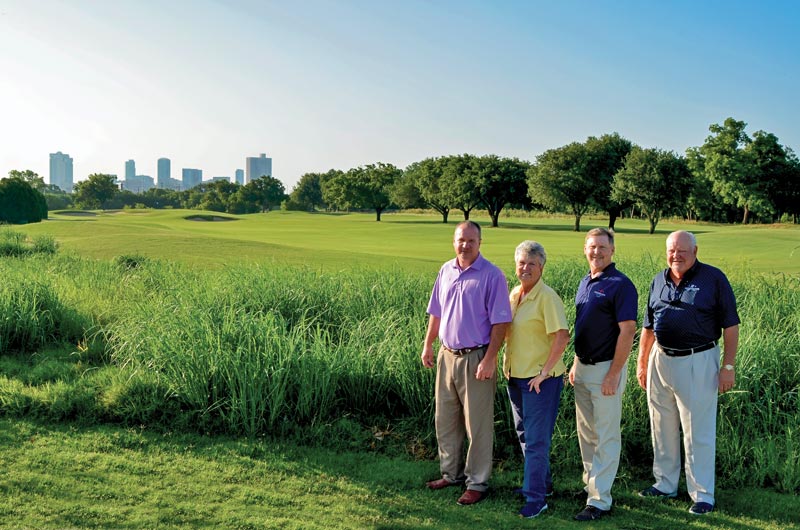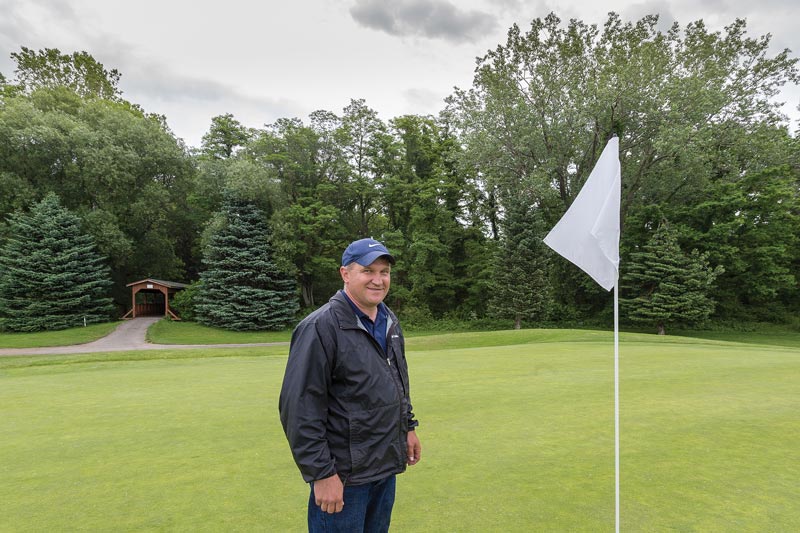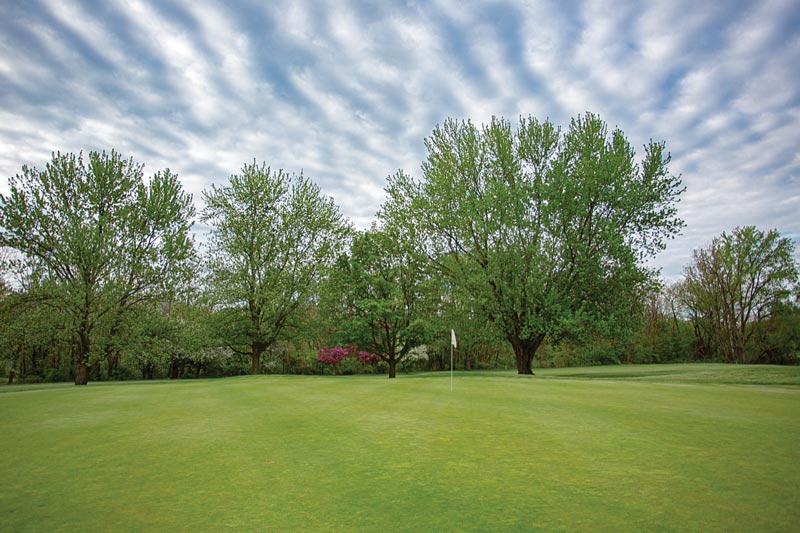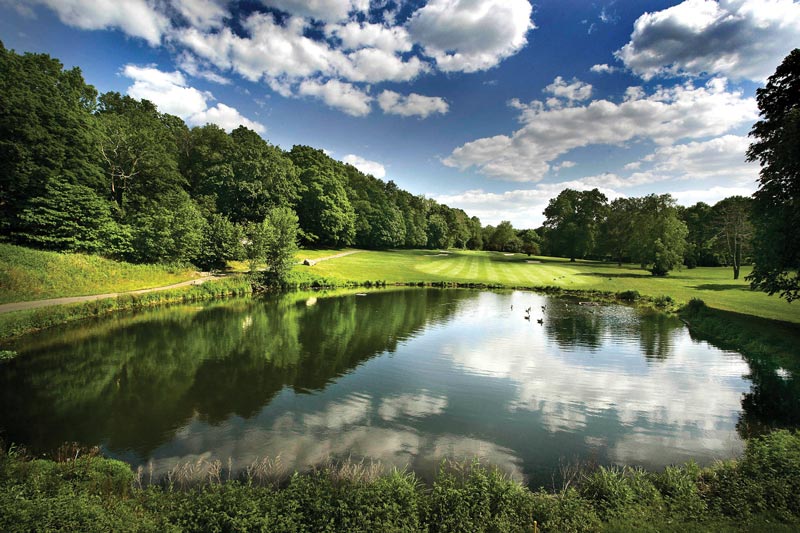
Rockwood Golf Club in Fort Worth, Texas, is just one example of an American municipal golf course that’s experiencing a revival. Those who have made an impact at Rockwood include, from left, Shawn Watson, head golf professional; Nancy Bunton, interim assistant director of parks; GCSAA Class A superintendent Bill Sturm; and ASGCA architect John Colligan. Photo by Trey Kemp
Statistics indicate that municipal golf courses are trendy. Woodland Hills Golf Course in Fort Scott, Kan., oozes chic in the heartland.
“When I got here eight years ago, only eight greens were open for play. The rest of them were dirt,” says 23-year GCSAA superintendent Jon Kindlesparger, who revealed a name he once heard to describe municipal golfers (more on that later). Issues had persisted at Woodland Hills long before Kindlesparger arrived. It was a country club in those dark days in the 1990s when the bank came calling on the note. Find another owner or the place would be shuttered, is what Fort Scott native Mitch Quick recollects. “We were putting on crabgrass greens,” Quick says.
A new owner emerged, but old problems remained in Fort Scott, which has a population of roughly 7,800 and is about 90 miles south of Kansas City. Ultimately, the city purchased Woodland Hills, and the results have been promising. The deficit has decreased as revenues continue to increase. “Give credit to the city and to Jon,” Quick says. “A dilapidated golf course now is a playable golf course.”
There are others of Woodland Hills’ kind in municipalities across America. The nationwide municipal golf course count reached a record high of 2,515 in 2018, according to the National Golf Foundation. The NGF adds that approximately 75% of all U.S. courses are open to all players, matching the highest public-to-private ratio in history. The increase, according to NGF, can be attributed to some public agencies acquiring formerly privately owned properties to control land use and/or to offer as an amenity to local residents.
Does that mean municipal courses have recovered from the crush of new course openings 20 some years ago that created more competition for them? If anything, they exhibit persistence.
“If you look at the model, generally, they (municipal golf courses) have great staying power, tend to not come and go, and, for the most part, are pretty stable,” says Steve Mona, executive director of We Are Golf. “If you live in a community with a golf course, you know it’s probably going to be around there for a long time.”
While some thrive, others fight to stay relevant — or stay open. Palmer Park Golf Course in Detroit, where legendary heavyweight boxer Joe Louis played, recently closed. On the flip side, city-owned Braemar Golf Course in Edina, Minn., was rebuilt and reopened May 18, 2018. “It poured, but we still had 150 people come out,” Braemar general manager Joe Abood says of the opening. “We don’t have open tee times right now. There’s a resurgence. The course has been a staple of the community.”

Braemar Golf Course in Edina, Minn., has quite a history. Fifty years ago, it hosted the PGA Tour’s Minnesota Golf Classic. Site of the USGA’s 1979 Women’s Amateur Public Links, Braemar closed three years ago before reopening in 2018. How has it been received? Finding a tee time is a task. The superintendent at Braemar is Jeff Mold. Photo courtesy of Joe Abood
Municipal golf courses are etched in the game’s roots. They serve as community cornerstones, incubators for learning the game — which has also seen a boost in play. The NGF reports that in 2018, for the first time in 14 years, the number of golfers in the U.S. age 6 and older who played at least one round increased — to 24.2 million, up from 23.8 million in 2017. The report also noted that the number of beginning golfers, 2.6 million, is near a historic high.
“Our first goal is, we’re growing the game to enable you to go to the country club if you want to. But we hope you stay here,” says GCSAA Class A superintendent Darin Pearson, park operations manager at Eagle Bend Golf Course & Learning Center in Lawrence, Kan., and a 25-year association member.
Major golf champion Fred Couples developed his game at municipal Jefferson Park Golf Course in Seattle. Municipal courses also host majors, such as in 2020, when the PGA Championship will go to TPC Harding Park in San Francisco. Golf Channel personality Matt Ginella touts municipal courses. “Municipal golf ... this, to me, is the most interesting conversation in the world of golf right now,” says Ginella, who adores his nine-hole course in Winter Park, Fla. “If I can get two hours to play the local muni, something I can count on, isn’t that what it’s all about?”
(Fort) Worth the wait
Henry Cagigal has taken countless looks at the fairways and greens of Fort Worth’s Rockwood Park over four decades. For him — and so many others — the dramatic comeback there, with its views of the downtown skyline, is a sight for sore eyes.
“It’s a complete new facility,” says Cagigal, 57, assistant golf professional at Rockwood.
Rockwood’s is a story of revival and survival. Rounds played are up more than 50% from 2015, and net profits have overtaken net losses despite an increase in operating costs.
The process to facilitate this moment was launched 10 years ago. That’s when Fort Worth officials completed the blueprint, endorsed by the park board, to renovate Rockwood. “Overhaul” is more like it. Rockwood, built in 1938, had never received any sufficient improvements.
“We didn’t have all the funds in place at that time (2009), but the master plan was in place for when the time presented itself,” says Nancy Bunton, interim assistant director of parks. The combination of a city bond package and $1.7 million in gas royalties for a total of approximately $5 million set the makeover in motion, with a 2017 course reopening.
“Municipal golf was going down and down. City leaders, from the top down, took a stand and believed in the golf division,” says Shawn Watson, Rockwood’s head golf professional.
Heritage Links in Houston handled the construction, and architect John Colligan, his associate Trey Kemp, and GCSAA Class A superintendent Bill Sturm authored the rest.


Before and after shots of what is currently No. 15 at Rockwood Golf Club. Architects John Colligan and Trey Kemp oversaw the renovations at Rockwood. How does Colligan view his work at Rockwood or anywhere else? “Golf should be enjoyed, not endured,” he says. “If we can create challenges for the better players and fun for the not-so-good player, we’ve accomplished what we wanted to do.” Photos courtesy of Trey Kemp
The rebuild featured massive modernizations: a new irrigation system, drainage, cart paths, greens (TifEagle bermudagrass), tees, fairways, Better Billy Bunkers and an additional 15 acres of native areas on the course, which was stretched from 6,300 yards to more than 7,000.
“Before, a lot of people compared the course to a bowling alley. It was just flat,” says Sturm, a 20-year association member. “They hadn’t changed anything. Everything, really. It was that bad. Greens were worn-out. Archaic equipment, like gang mowers, were used on fairways. Now, it’s totally different. I cannot give John (Colligan) enough props. I don’t have a big budget, but it’s the easiest course I’ve had to maintain. Our attitude is to keep the conditioning, the details, to a country club level.”
Colligan was raised in the area and played the course 45 years ago when conditions were already suspect. “It sloped. You couldn’t keep the ball in the fairway, and there wasn’t much grass in the fairways,” Colligan says. “It was overdue for some TLC.” He credits Kemp, whom he calls “a whiz” at rerouting and conquering flood plain issues at Rockwood. Being a local made this job extra special for Colligan. It was timely for business, too. “During the economic downturn, munis kept us going,” he says.
They’re not done yet revamping Rockwood, home to The First Tee of Fort Worth. More facility upgrades are on the horizon, including a new clubhouse and, Sturm hopes, improvements at the maintenance facility, which is located in a flood plain and close enough that he can hit a wedge into the Trinity River.
Bunton, meanwhile, views municipal golf as a key to helping the industry grow. “There always seem to be questions whether municipalities should be in the golf business. I think municipal golf courses are able to keep costs down a little and provide accessibility for all golfers,” she says.
A USGA champ champions Pennsylvania course
John Jackson has vivid memories of Downing Golf Course in Harborcreek, Pa. — some from even before the plane landed.
“On the flight in to Erie (Pa.), they came on and announced they’d had 24 inches of rain the week before,” Jackson says, “but I ended up having a good time.” In 1969, Jackson won the U.S. Amateur Public Links Championship at Downing. “The greens were just excellent,” says Jackson, who in his career made two cuts in the PGA Championship and is currently the general manager at Corte Bella Golf Club in Sun City West, Ariz. “It was as good a golf course as I had played.”


GCSAA Class A superintendent Alan Zielinski (above) oversees Downing Golf Course in Harborcreek, Pa., which hosted the USGA’s U.S. Amateur Public Links 50 years ago. The course has been buoyed by implementing the Longleaf Tee Initiative, designed to increase course playability and enjoyment for players of all ages and skills. This month, Downing Golf Course will host the Erie District Amateur Championship. Photos by Karen Bukowski
Nowadays, GCSAA Class A superintendent Alan Zielinski, who has been on the job since 2005, oversees Downing and nine-hole J.C. Martin Golf Course, courses where the city is always exploring creative ways to increase revenue while attracting new golfers. As other municipal courses have encountered, having revenues exceed expenses has at times been challenging.
Zielinski, meanwhile, goes about his business.
“I took several business classes at Penn State and learned then to be budget-minded,” says Zielinski, a 23-year association member. “The way I see it, you treat this as your own business. If you do that, I think you’ll always make good decisions.”
Downing implemented the Longleaf Tee Initiative, modeled after Longleaf Golf & Family Club in Southern Pines, N.C., and designed to increase course playability and golfer enjoyment for players of all ages and skill sets. “We’ve had people who hadn’t been here in a few years come back, and they’re thrilled,” says Karen Bukowski, Downing’s golf professional. “Municipal golf courses sometimes have limited budgets and resources, but Alan’s done an amazing job with what he has.”
Zielinski’s staff members are all part-timers, many of them retired. Downing isn’t holding a USGA-level event, but its Erie District Amateur Championship, which starts Aug. 16, is a big deal. “They’re used to playing country club conditions. We’ll put our best foot forward,” Zielinski says. “We’ll make the place shine, the best it can be.”
Beating the odds in Vegas
Who doesn’t want to make a haul in Las Vegas? This particular haul, however, had nothing to do with hitting the jackpot.
An episode spawned by Mother Nature was so devastating that it precipitated a name change at a municipal facility known in 2012 as Desert Rose Golf Course. The property was slammed seven years ago by floods that destroyed homes, businesses and the golf course, which was built in 1964.
The facility was renamed The Club at Sunrise and is now managed by KemperSports. Director of agronomy Scott Sutton surveyed the 2012 storm’s aftermath as 600,000 cubic yards of material (much of it silt) was hauled off the property. “Seventy-five dump trucks were parked out here, coming and going from 6 a.m. to 6 p.m. every 90 seconds for five to six months,” says Sutton, a 28-year GCSAA member.
To prevent another catastrophic flood, Clark County spent $150 million on the Las Vegas Wash project, which enlarged the flood channel (including removing more than half a million cubic feet of soil from the course) and rebuilt the golf course’s layout with help from Heckenkemper Golf Course Design (Sunrise is located smack-dab in the middle of the Las Vegas Wash project). Heckenkemper’s blueprint featured a channel redesign to accommodate back-to-back 100-year storm events while maximizing golf playability.
Sutton never felt as if he were rolling the dice during the rebuild when he carpeted Sunrise with wall-to-wall Platinum TE seashore paspalum, which is uncommon for desert courses (Sunrise uses reclaimed water). Sutton had successfully tested paspalum when he oversaw Wildhorse Golf Club in Henderson, Nev. “I had areas that couldn’t grow bermudagrass. There were questions whether it (paspalum) would grow in our climate,” Sutton says. “I did 15 acres (of paspalum) and became a true believer.”
So are outsiders. Jim R. on the TripAdvisor website said this about Sunrise in 2018: “A greenskeeper who knows how to really do his job and it shows.”
Sunrise general manager Matt Kalbak anticipates 33,600 rounds will be played in fiscal year 2019, which would be a more than 2,500-round increase from a year ago at Sunrise, where residents pay $32 on weekdays and $39 on weekends to play 18. Kalbak is also a big Sutton fan. Sutton’s greens, Kalbak says, are unmatched in the area. “Never been around a superintendent in my life that works harder than this guy does,” Kalbak says.
Sutton was the Southern Nevada GCSA Superintendent of the Year in 2017, and he is this year’s recipient of the Tomiyasu Award, presented in honor of Bill Tomiyasu, a southern Nevada farmer/horticulturist who popularized many trees and plants in the region. Sutton is, as they say in Vegas, all-in at Sunrise, which reopened in 2016. In fact, he has been invested there for a long time. It’s where Sutton learned how to play when it was Desert Rose. “We want to make the golf course a hub for the community,” Sutton says. “Homeowners seem content. It’s getting to be a happy place again.”
The ‘L’ word
Back at Woodland Hills, Kindlesparger has a name for municipal golfers.
He first heard it years ago. It refers to golfers who don’t store their golf clubs at the course, unlike members who may keep their clubs at a private facility. “We’ve got everybody from lid-slammers to ex-country clubbers here,” Kindlesparger says. “Lid-slammers” refers to municipal golfers who open the trunks of their vehicles, pull out their clubs and then slam the trunk lids. Kindlesparger encourages all the lid-slammers who help anchor municipal golf to slam away.
“Are we (municipal golf courses) going to get a company to move in? Maybe not,” Kindlesparger says. “But it may help somebody consider moving in to a place that’s got decent parks, good schools and also has a golf course. I think we’re part of the package of amenities — an amenity I feel very strongly about.”
Van Cortlandt Park Golf Course: First, but not the last
Baseball greats Willie Mays and Babe Ruth played there. So did Academy Award-winning actor Sidney Poitier. We’re not sure they took the subway to get there, but their northwest Bronx, N.Y., destination is thought to be the first of its kind.
According to its website, Van Cortlandt Park Golf Course in New York City “made history as the nation’s first municipal golf course when it opened in 1895.” Known by locals as “Vannie,” Van Cortlandt Park GC is a key attraction at Van Cortlandt Park, which includes Van Cortlandt Lake, a museum, a nature center, sports fields, a multiuse stadium and stables. At one time, it featured three ski slopes on the back nine.
Scottish-born architect Tom Bendelow redesigned, constructed (adding nine holes to make it a total of 18) and helped maintain Van Cortlandt Park GC in the late 1890s, and architect Stephen Kay led a modern-day renovation.

A view at Van Cortlandt Park Golf Course in New York City. Photo courtesy of Van Cortlandt Park Golf Course
Thirteen years ago, Westchester Metropolitan Golf Association Player of the Year Andrew Giuliani, son of former New York City Mayor Rudy Giuliani, called Van Cortlandt his home course. He went on to play at Duke University. Today, Van Cortlandt Park GC remains relevant — a testament to its importance and longevity among the annals of American municipal golf courses.
“We average about 45,000 rounds a year,” says Chris Ryan, Van Cortlandt Park GC general manager. “Our importance? It means we are the first course open to the public that people could come and play.”
Jim Buonaiuto worked at Van Cortlandt Park GC from 2004 to 2008. He still plays there occasionally, and he credits superintendent Peter DiRollo and his crew for the job they do at a spot Buonaiuto says represents the spirit of municipal golf. “Golf at first was not public. At Van Cortlandt, you have blue-collar workers, executives and people who came as kids to play for the first time,” says Buonaiuto, general manager at Rye (N.Y.) Golf Club. “It’s the melting pot of golf.”
Howard Richman is GCM’s associate editor.